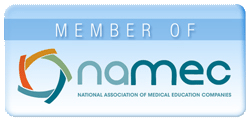Improving Detection and Patient Care in Post-Stroke Spasticity
Compass Points
Premiere Date: Tuesday, February 19, 2013This activity offers CE credit for:
- Physicians (CME)
- Other
All other clinicians will receive a Certificate of Attendance stating this activity was certified for AMA PRA Category 1 Credit™
Credit Expiration Date:
Wednesday, February 19, 2014
Note: Credit Is No Longer Available
 | Monique Johnson, MD, CCMEP Medical Program Director CME Outfitters, LLC Bethesda, MD |
 | Stephanie Bond, EMT-Basic Educational Outcomes and Content Intern CME Outfitters, LLC Bethesda, MD |
Adults with history of stroke are at risk for numerous neurologic sequelae. Among these, spasticity is a frequent finding, affecting estimated 20% to 40% of stroke survivors and resulting in significant reductions in their ability to perform activities of daily living and in their health-related quality of life. Clinical gaps exist in the recognition and evaluation of post-stroke spasticity (PSS). Evidence indicates that patients with PSS often do not receive care that is consistent with well-established practice guidelines for post-stroke rehabilitation. Continuing medical education is an important strategic asset that can be used to address these gaps and foster improved care for patients with PSS.
This Compass Points™ article provides an overview of PSS, with a focus on selecting clinical measures for PSS assessment and integrating nonpharmacological and pharmacological therapeutic modalities. Readers of this article are also directed to the January 15, 2013 supplement of the journal Neurology that is dedicated to the topic.
To educate clinicians on guideline-recommended strategies for recognition, evaluation, and management of post-stroke spasticity.
At the end of this CE activity, participants should be able to:
- Identify health-related quality of life (HRQoL) issues in patients with post-stroke spasticity.
- Describe at least two tools commonly used to assess the levels of impairment or functional limitations or response to therapy in patients with post-stroke spasticity (PSS).
- Increase the rate at which an integrated strategy of nonpharmacological and pharmacological modalities to treat post-stroke spasticity is used.
This educational activity is supported by CME Outfitters, LLC.
Physicians, physician assistants, and other physician extenders or health care professionals who are members of the patient’s health care team.
CME Credit (Physicians):
CME Outfitters, LLC, is accredited by the Accreditation Council for Continuing Medical Education to provide continuing medical education for physicians.
CME Outfitters, LLC, designates this enduring material for a maximum of .50 AMA PRA Category 1 Credit™. Physicians should claim only the credit commensurate with the extent of their participation in the activity.
Post-tests, credit request forms, and activity evaluations must be completed online at www.cmeoutfitters.com/TST766 (requires free account activation), and participants can print their certificate or statement of credit immediately (80% pass rate required). This website supports all browsers except Internet Explorer for Mac. For complete technical requirements and privacy policy, visit www.neurosciencecme.com/technical.asp.
Disclosure Declaration
It is the policy of CME Outfitters, LLC, to ensure independence, balance, objectivity, and scientific rigor and integrity in all of their CE activities. Faculty must disclose to the participants any relationships with commercial companies whose products or devices may be mentioned in faculty presentations, or with the commercial supporter of this CE activity. CME Outfitters, LLC, has evaluated, identified, and attempted to resolve any potential conflicts of interest through a rigorous content validation procedure, use of evidence-based data/research, and a multidisciplinary peer review process. The following information is for participant information only. It is not assumed that these relationships will have a negative impact on the presentations.
Dr. Johnson has no disclosures to report.
Stephanie Bond has no disclosures to report.
Howard Bliwise, MD, (peer/content reviewer) has no disclosures to report.
Joy Bartnett Leffler, MLA, NASW, CSE (planning committee) has no disclosures to report.
Sandra Haas Binford, MAEd (planning committee) has no disclosures to report.
Sharon Tordoff, CCMEP (planning committee) has no disclosures to report.
Unlabeled Use Disclosure
Faculty of this CE activity may include discussions of products or devices that are not currently labeled for use by the FDA. The faculty have been informed of their responsibility to disclose to the audience if they will be discussing off-label or investigational uses (any uses not approved by the FDA) of products or devices.
CME Outfitters, LLC, and the faculty do not endorse the use of any product outside of the FDA labeled indications. Medical professionals should not utilize the procedures, products, or diagnosis techniques discussed during this activity without evaluation of their patient for contraindications or dangers of use.
Questions about this activity? Call us at 877.CME.PROS (877.263.7767).
CC-051-021913-00



